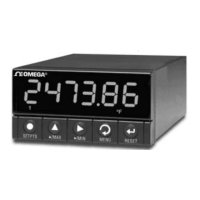24
80
Alarm Configuration Menu
ACt IVE
Press ‘RESET/ENTER’ 5) Display shows "ACt IVE" Alarm Active State submenu.
Press ‘RESET/ENTER’ 6) Display flashes "AbOVE" Above Alarm/Setpoint active state option or
previous setting.
Press ‘䊱/MAX’ 7) Scroll to select 2 available options for your choice "AbOVE" or "bELOU"
(below) Alarm/Setpoint Active State.
Press ‘RESET/ENTER’ 8) Display shows "StOREd" stored message momentarily and then
advances to "LAtCH" Alarm Latching submenu.
LAtCH
Press ‘RESET/ENTER’ 9) Display flashes "UNLtCH" Unlatch Option or previous setting.
Press ‘䊱/MAX’ 10) Scroll to select 2 available options for your choice:
"UNLtCH" (unlatch) Non-Latching or "LAtCH" Latching Action. This means
that once Alarm1 (Setpoint3) is triggered it will remain active, if "LAtCH"
was selected, until it is reset by pressing the ‘RESET/ENTER’ button one
time or by grounding connector P2-11. Reset can also be accomplished via
RS-232 or RS-485 serial communication option board.
N.StAtE
Press ‘RESET/ENTER’ 11) Display shows "StOREd" stored message momentarily and then
advances to "N.StAtE" Normal State (Output-transistor Collector or Relay
state) submenu.
Press ‘RESET/ENTER’ 12) Display flashes "N.OPEN" Normal Open (Output Relay or
Output-Transistor Collector opened) state or previous setting "N.CLOSE"
Normal close state.
Press ‘䊱/MAX’ 13) Select your choice of Output Relay or Output-transistor Collector state
setting.
AL.MOdE
Alarm Mode or Deviation functions apply to Alarms 1 and 2 (Setpoints 3
and 4) and act as buffer zones to control setpoint action. The Alarm 1
deviation is the sum of the Alarm 1 value plus the Setpoint1 value the
Alarm 2 deviation is the Alarm 2 value plus the Setpoint 2 value.
Press ‘RESET/ENTER’ 14) Display shows "StOREd" stored message momentarily and then
advances to "AL.MOdE" Alarm Mode (Function) Configuration submenu.

